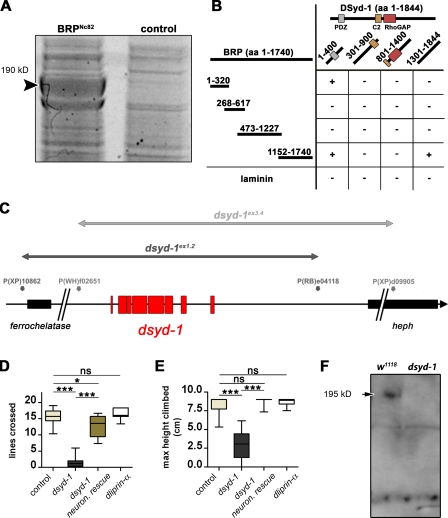Figure 1.
Proteomics identify DSyd-1 as physical interactor of BRP. (A) Monoclonal BRPNc82 efficiently precipitates BRP (arrowhead), as seen in this SYPRO red–stained SDS-gel. Among other proteins, DSyd-1 was found to coprecipitate with BRP, as confirmed by MS/MS analysis. (B) Matrix showing yeast two-hybrid assay results confirming a direct physical interaction between BRP and DSyd-1. A C-terminal domain of BRP (aa 1,152–1,740) was positive for interaction with a C-terminal region of DSyd-1 (aa 1,301–1,844). Moreover, a bait N-terminal DSyd-1 (aa 1–400) fragment interacted with both the N-terminal fragment of BRP (aa 1–320) and a C-terminal BRP (aa 1,152–1,740) fragment. (C) Genomic location of dsyd-1 on chromosome arm 3R at 100D2-100D3. dsyd-1–deficient animals were constructed using Drosophila lines carrying transposon-mediated flippase recognition target sites (Parks et al., 2004) that neighbored the dsyd-1 locus (black, dsyd-1ex1.2; gray, dsyd-1ex3.4 in gray). We obtained two deficiencies that were confirmed with genomic PCR. In both cases, the entire dsyd-1 locus (red) was excised, whereas in one case (dsyd-1ex1.2, black line), the 5′ ferrochelatase was affected; and in the other case, the 3′ heph (dsyd-1ex3.4, gray line) locus was affected. Taking these deficiencies in trans eliminates both copies of dsyd-1; however, this leaves one intact copy of each heph and ferrochelatase. (D and E) Behavioral tests demonstrate a requirement for DSyd-1 and less stringent requirement for DLiprin-α in the adult CNS. (D) Walking ability (control: 15.69 ± 0.57 lines, n = 15; dsyd-1: 1.62 ± 0.69 lines, n = 8; dsyd-1rescue: 12.86 ± 0.99 lines, n = 10; dliprin-α: 16.19 ± 0.65 lines, n = 7; control × dsyd-1: P = 0.0001; control × dsyd-1rescue: P = 0.02; control × dliprin-α: P = 0.67; dsyd-1 × dsyd-1rescue: P < 0.0001). (E) Negative geotaxis (control: 8.32 ± 0.37 cm; dsyd-1: 2.92 ± 0.60 cm; dsyd-1rescue: 8.833 ± 0.17 cm; dliprin-α: 8.67 ± 0.15 cm; all: n = 10; control × dsyd-1: P < 0.0001; control × dsyd-1rescue: P = 0.32; control × dliprin-α: P = 0.91; dsyd-1 × dsyd-1rescue: P < 0.0001). Impaired locomotive behavior in dsyd-1 flies is rescued by pan-neural (elav-GAL4) reexpression of the dsyd-1 cDNA. Error bars indicate the SEM. *, P < 0.05; ***, P < 0.005; ns, P > 0.05. (F) A polyclonal α-DSyd-1 antibody recognizes a band at the predicted molecular mass of 195 kD on immunoblots of w1118 control fly head lysate (arrow). This band is missing in dsyd-1 head extracts. Statistics: Mann-Whitney test.

